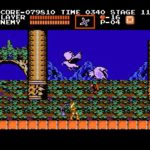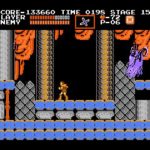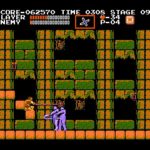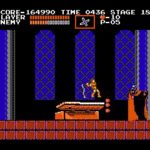Developer: Konami Publisher: Konami Released: May 1987 Genre: Action
Castlevania was a game ahead of its time. When the NES launched in the US for the majority of that first year its main software came from Nintendo. As the third party titles began to trickle on to shelves it became obvious that Nintendo’s games were head and shoulders above stuff like Adventure Island and whatever abomination Capcom contracted Micronics to produce. Castlevania, hell nearly all of Konami’s work back then seemed to come from another planet in comparison. With its macabre setting and unique gameplay Castlevania would help establish Konami as one of the NES’ best developers. Its significance extends even further than that however.
Castlevania was among the second generation of NES software. These titles (Metroid, Kid Icarus, Mega Man) were both technically advanced and began to push the boundaries of game design. As the first in the series Castlevania established the majority of the tenets subsequent games would follow. Although it is unflinchingly hard to this day anyone can still see the brilliant design that lies underneath and understand why the series has become a legend.
At its release Castlevania was unlike anything else on the market. I am sure there were games with a horror theme back during the Atari 2600 era. However the technology was not there to properly convey the artist’s intent. With its gothic art style and exquisite pixel art this was a clear step ahead of any other console game on the market. It was also highly influential to later games such as Ninja Gaiden. It isn’t a stretch to say that it had a large impact on my gaming tastes growing up. While I wish the difficulty was not so steep it is still enjoyable even today.
Simon’s controls require an adjustment period that I’m sure will turn some away. Unlike the agile protagonists of other platformers Simon’s movement is rigid. Controlling the distance of your jumps, even changing direction, things that Mario and Mega Man made us accustomed to, does not exist. Once you perform an action you commit to it. The whip is an unconventional weapon as it lacked the immediacy of a gun or fireballs. Supplementing this are the various tools of a vampire hunter such as holy water, the cross, a weak knife, and throwing axes. Oddly enough hearts power these weapons and can be further enhanced to allow 2-3 projectiles at once.
The most distinct aspect of Castlevania as a whole is its pace. For those coming off of Mario Simon’s limited mobility will definitely feel like a step back. But therein lies the genius of its design, the way all of its constituent parts work together. The entire game is built around this, from the measured jumps to the exact enemy placement. The game would simply not work with a more nimble protagonist. There’s a level of terror present whenever a Medusa head, one of the smallest enemies in the game, appears. Seeing how fast and erratically they move compared to your limited tool set is legitimately frightening. Guiding Simon to the game’s conclusion with the restrictions imposed upon you is an honest triumph as a result.
Actually making it that far however is a trial in and of itself. Early NES games are notorious for their difficulty as most developers were still learning how to properly balance their games. Even bearing that in mind Castlevania is still one of the hardest games in the system’s library. With each passing level the amount of damage you take rises by one point. By the fifth stage you can suffer a mere four hits before death. Life restoring chicken becomes scarce and extremely well hidden. Even standard enemies such as the axe knights take up to 9 hits before going down. That is insane.
The boss battles are even more brutal, to the point where certain weapons are almost mandatory. I still have nightmares about the Grim Reaper and honestly thought he was unbeatable when I was young. When I finally beat him using the triple cross it was one of the most satisfying victories of my youth. Dracula was far easier in comparison so long as you don’t become anxious and rush.
In spite of the spikes in difficulty however the game still remains fun. There are a large number of secrets in random blocks throughout the world, a trait borrowed from Super Mario Bros. While difficult when you fail it is almost always your fault. Whether you misread a jump or suffer knockback into a pit, it is soul crushing when you see it coming. This is a game where literally every step needs consideration. You either play the game the way the creators intended or give up in frustration.
For its time Castlevania might have been the best looking NES game on the market. The Gothic artwork and the intricate detail of its backdrops were simply in a class by itself. Fading wallpaper and decrepit masonry sell the idea that this was a decaying castle. Despite using the standard assortment of Universal monsters as its enemies they still felt unique in the world Konami built. The haunting soundtrack is one of the best on the system, a tradition that would follow on every subsequent platform.
In Closing
Although we are 30 years removed from its original release Castlevania is still every bit a classic. It can be hard to go back to such a rigid control scheme, especially as the series would evolve and the difficulty is a tad too high. However the game is still just as compelling now as it was then if you have the patience.










2 thoughts on “Castlevania”